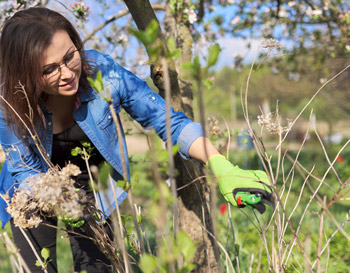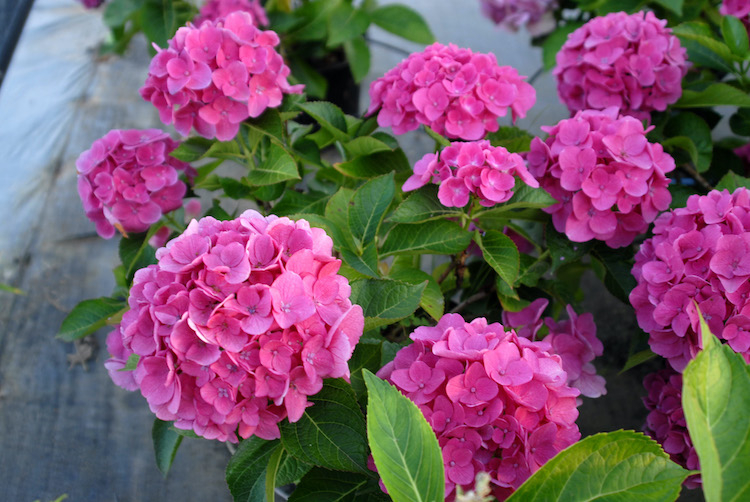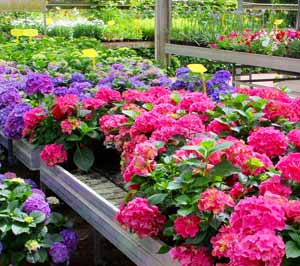Hydrangea Pruning in Arkansas
Searcy, Ark. –
 With so many hydrangea selections available, and new ones appearing annually, coupled
with the wide range of conditions they can grow in, there is a hydrangea for almost
every garden. Choosing the right hydrangea for your yard can be a daunting task, and
knowing how and when to prune it may be even more so.
With so many hydrangea selections available, and new ones appearing annually, coupled
with the wide range of conditions they can grow in, there is a hydrangea for almost
every garden. Choosing the right hydrangea for your yard can be a daunting task, and
knowing how and when to prune it may be even more so.
Not all hydrangeas are the same and pruning at the wrong time won’t kill the plant, but you may lose a season of blooms.
Check out our resource library to view hydrangea species.
When should I prune my hydrangea?
The season of pruning is not the same for all hydrangeas.
Some plants bloom on the new growth—Hydrangea paniculata and H. arborescens, so can be pruned before growth begins in early spring or as they are going dormant in the fall. Others bloom on the old growth, so should only be pruned after flowering; Hydrangea macrophylla and H. quercifolia fit into this category.

The most common hydrangea grown in our gardens is Hydrangea macrophylla—the big leaf hydrangea. This hydrangea is the one that produces the large pink or blue flowers (depending on pH of the soil) and can be seen gracing homes across the country. Some varieties are more cold tolerant than others, varieties vary from hardy to zone 4 to zone 9. Winter damage is a common complaint and can cause the plants to be killed to the ground in the winter—which often leads to a lack of flowers for that season. So, choose your varieties wisely, especially if you live in colder zones.
Hydrangea macrophylla typically blooms in late spring or early summer depending on where you live. It sets its flower buds for the next season on the old wood, after it blooms, in late summer to early fall as the days get shorter and temperatures cool off. The ideal time to prune—if needed, is immediately as the flowers begin to fade. Try to have all pruning done by August. The later they are pruned the smaller your flowers will be the next season. Often the earlier you get it done after bloom, the quicker the recovery and the more blooms next season.
Some gardeners prune a few canes each season, while others wait until the plants have overgrown their location, or when the flowers become smaller and less showy. If the plant gets old and woody, it can often produce smaller blooms. Since hydrangeas produce multiple trunks or canes, any pruning should remove the older canes at the soil line. Don’t top-prune hydrangea canes, as this will result in branching. H. macrophylla produces large terminal flower buds on the end of each branch. They are readily visible at the tips of the branches in the winter when the plants are devoid of leaves. If you have a multi branched stalk with large buds on the tip of each branch, the stem resembles a candelabra. The weight of the resulting blooms can cause the stalk to bend and sometimes break when in flower.
When pruning, cut the older canes out as close to the soil line as possible. This should reduce the overall size and height of the plant, while leaving ample remaining stems for showy blooms the next season.
How do I care for my hydrangea during the winter?
Keep in mind that hydrangeas are not the most gorgeous dormant plant. They usually look like a bunch of dead sticks in the winter—so don’t have them in the most prominent part of your winter landscape.
Some gardeners erroneously think their big leaf hydrangeas are dead sticks and prune them to the ground each winter. They rarely see a flower on their plants.
Protect the plants as much as possible in the winter. If the terminal bud begins to sprout, which often happens when we have a warm spell in the winter, a following hard freeze can kill the bud. When this happens, there are usually smaller flower buds further down on the stem which can take their place and bloom in the summer. The flowers produced from these smaller buds will not be as large and showy as those from a terminal bud, but they are still quite nice.
Will my hydrangea recover from winter-related injury?
If there is a hard winter, and you have less than hardy varieties, the entire plant can be killed to the ground. The plant will re-grow from the root system, but you will usually have few, if any, blooms that growing season.
There are a few varieties of H. macrophylla that are remontant – which means they can have more than one bloom cycle. One of the varieties getting a lot of press now is Endless Summer. This H. macrophylla will bloom throughout the summer and will bloom on new growth even if the old growth is winter damaged. For remontant types, deadhead the spent flowers throughout the growing season, just like you would your perennial flowers. This will encourage them to set more flowers. They bloom on both the old and the new wood.
Try to plant your hydrangeas in a location where maximum size can be utilized, and this can cut down on your pruning chores. When they do need pruning, remove up to one third of the old canes at the soil line either after the first bloom or before growth begins in the spring.
Should I deadhead the spent flowers? Does it depend on the variety?
Deadheading is a process where spent flowers are removed. There are several schools of thought about this. Some gardeners like the look of the dried blooms on their plants, and even consider it an extra form of winter protection for their flower buds. They clip off the spent blooms as the buds begin to emerge in the spring.
Others find the spent flowers an eyesore and remove them as the flower color fades. Either option is fine, just be careful about how much stem is cut when you do deadhead.
The earlier you prune them off, the longer the stem can be. The later you deadhead, make sure you are simply just removing the flower head with very little stem. You don’t want to damage any flower buds which may have already formed.
Hydrangea quercifolia, the oak leaf hydrangea usually doesn’t require as much pruning, provided it has ample room to grow. If pruning is needed, follow the same guidelines as for H. macrophylla.
Hydrangea paniculata (panicle hydrangea) and H. arborescens (smooth hydrangea) require a totally different method of pruning and are both much more forgiving if pruning is not done at a certain time.
Other than pruning when flower buds are opening, you really can’t mess these up too easily. The panicle (PeeGee) hydrangea can be formed into a tree, with very little pruning other than shaping done each year before growth begins in the spring. It can be pruned hard if needed, but do so before it begins to leaf out in the spring. H. arborescens or the smooth hydrangea (Annabelle) may or may not be pruned hard before growth begins. The smooth hydrangea will produce much larger blooms if pruned hard each year, but many gardeners opt for smaller blooms on sturdier stems. Annabelle’s branches often fall over under the weight of their blooms, especially after irrigation or a good rain.
Pruning crossover branches and pruning for structure and support by cutting stems to a heading of 18 – 24 inches can give you a sturdier branch to support the blooms, but even then you may need some additional plant supports to keep the branches upright. Some gardeners in northern regions shear them to the ground each year in the fall, then mulch since the stalks would often be killed back anyway.
 How do I select the right hydrangea for my landscape?
How do I select the right hydrangea for my landscape?
Today nurseries and garden centers are carrying a wide array of hydrangeas. Make sure you choose a variety that will suit your landscape needs, as well as the site.
Most of them like some water, and most prefer a little protection from the hot afternoon sun—especially in the south, but there are exceptions to every rule. With good choices, and correct timing with pruning, your hydrangeas can stop traffic every year when in bloom.
Visit our resource library to see different hydrangea species.
For additional information on horticulture related topics, contact the White County Extension Service at 501-268-5394 or Sherri Sanders by email at ssanders@uada.edu.
The University of Arkansas System, Division of Agriculture is an equal opportunity/equal access/affirmative action institution.
###
By Sherri Sanders
County Extension Agent - Agriculture
The Cooperative Extension Service
U of A System Division of Agriculture
Media Contact: Sherri Sanders
County Extension Agent - Agriculture
U of A Division of Agriculture
White County Cooperative Extension Service
2400 Old Searcy Landing Road Searcy AR 72143
(501) 268-5394
ssanders@uada.edu